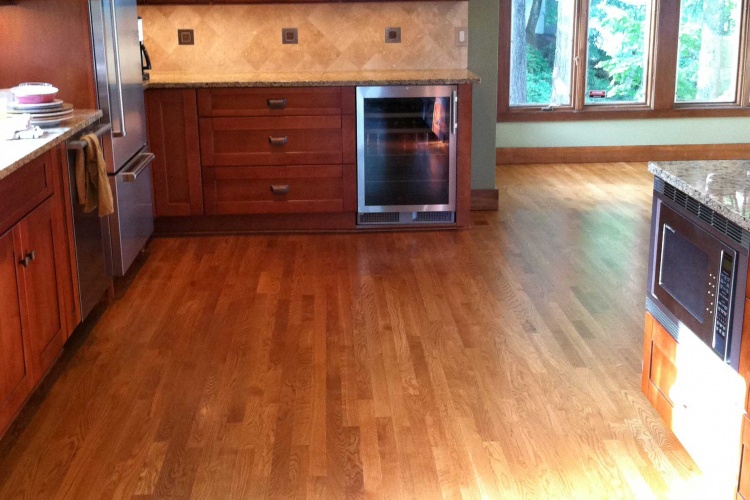There are many options to choose from when deciding to install new floors. If you are wondering why hardwood floors are better, we’ve compiled a list of reasons why they are.
#1 Easier, Faster, Low-Chemical Cleaning
Many think that carpet or tile is easier to clean. That isn’t true. Hardwood doesn’t grow mold between grout, hold bacteria in fibers, or trap dust. All your floors need is a simple mop and an occasional non-aerosol spray. Avoid oil-based cleaners; they leave behind film. This affects how a re-coat finish sticks to the old coat later. It’s safe to say that a damp mop with plain old water is the best way to clean your floors. It takes less than half the time it would take to vacuum, scrub, or shampoo other floor surfaces. Find out more
#2 Increase Value to Your Home
Real wood floors are the simplest and best way to boost your home’s resale value. They also last the life of the home. Carpet needs replacing up to six times before most wood floors need refinishing or repaired. They not only cost less in the long term, but also add value to your home.
#3 Recyclable
Our industry helps preserve what is already there. This makes it the finest form of recycling.
#4 Low Allergins
We spend 90 percent of our time indoors. Other surfaces harbor allergens, while wood does not trap dust, fumes, dust mites, or mold. Some researchers believe the dust mite could be responsible for increasing asthma occurrence. According to the American Lung Association, wood floors can improve air quality.
#5 Best Choice for the Environment
Wood manufacturing is much cleaner than the manufacture of other building materials. Steel creates 40 times more pollutants than wood, 6 times more than concrete, and 4 times more than brick. It also creates 3 times more carbon dioxide than wood, and concrete releases even more. Wood sends less solid waste to the landfill than steel or concrete. It is also more energy-efficient. The cellular structure of wood traps air, giving it superior insulating properties. It takes 15 inches of concrete to equal the insulation quality of 1 inch of wood!
#6 Easier to Update
Wood floors can change with stains, paints and inlays; without replacing any materials.
#7 Preferred for Joints
Wood gives. This is why hardwood floors are better for your legs and feet. Doctors recommend wood floors for spine and joints. Have you noticed that your feet get tired faster when standing on stone or tile, than on wood?
#8 Diverse in Color and Grain Patterns
There is more diversity in wood floors now than ever before. You can choose between dark wood or light wood, domestic or exotic flooring. You can also choose whether you want fine or smooth wood to cover your floors or go for a more grainy, rustic feel. Each option adds natural beauty to your home. You can reapply finishes as long as you follow maintenance procedures. You can re-coat wood floors to hide imperfections from every day use, or add toughness to your floors.
#9 Renewable Resource
North America has approximately 70 percent more forest cover than the 1600s. We produce more wood than any other place on the planet! This means we grow more than we cut.
#10 More Environmental Facts About Why Hardwood Floors are Better:
- Indoor air quality if better with wood floors.
(Source: US Environmental Protection Agency) - Wood floors last hundreds of years. Thus, it doesn’t need replacing as often as other flooring options.
(Source: National Association of Home Builders) - The average annual net growth for hardwoods is greater than average annual removals.
(Source: US Department of Agriculture Forest Service) - Wood is a carbon neutral product that produces oxygen during its growth cycle and stores carbon during its service life.
(Source: University of Wisconsin Wood Products Program Solid Wood Flooring Life Cycle Analysis) - Wood floors use less water and energy to produce than other flooring options.
(Source: University of Wisconsin Wood Products Program Solid Wood Flooring Life Cycle Analysis) - At the end of its service life, wood flooring can be burned as fuel or recycled.
(Source: University of Wisconsin Wood Products Program Solid Wood Flooring Life Cycle Analysis) - It takes most hardwood trees 40-60 years to mature. Inventory planted today won’t be used for 100-plus years.
(Source: National Wood Flooring Association)
To learn more about why hardwood floors are better for the environment, download a copy of the University of Wisconsin Wood Products Program Solid Wood Flooring Life Cycle Analysis.
Click here to see the full report for engineered wood flooring
Click here to see the full report for solid wood flooring
Click here to see the full report for engineered wood flooring
Click here to see the full report for solid wood flooring
Have Questions? Ask Us!
Get the answers you’re looking for. Talk to a specialist today!

